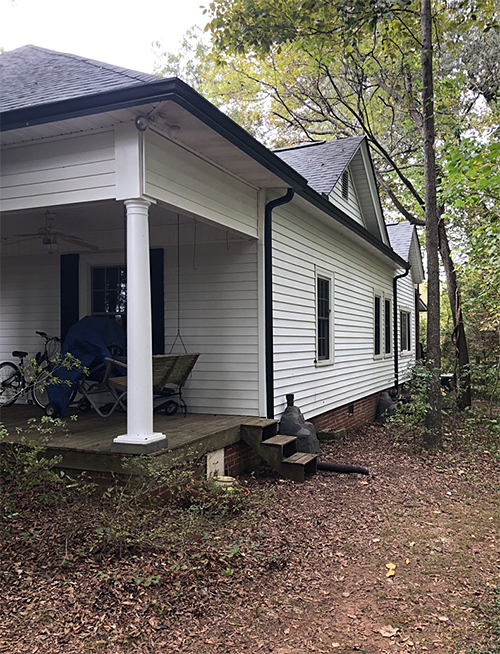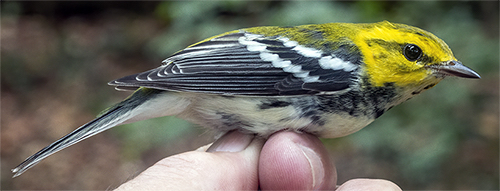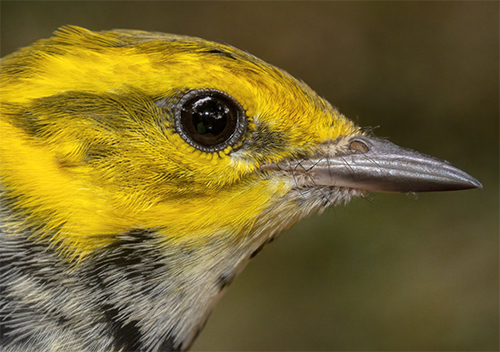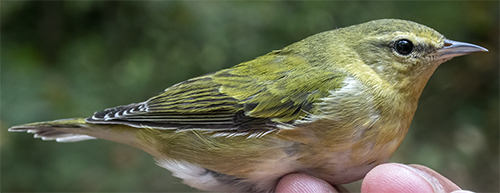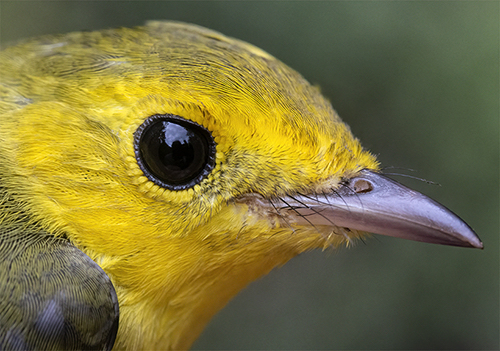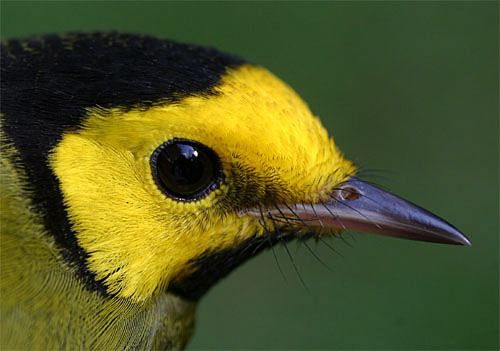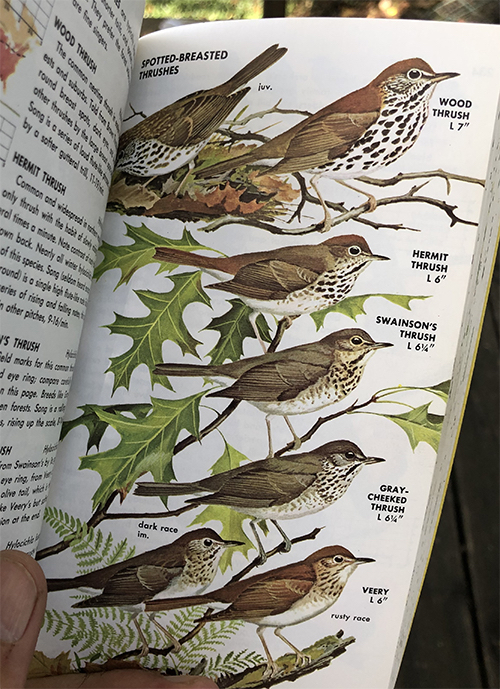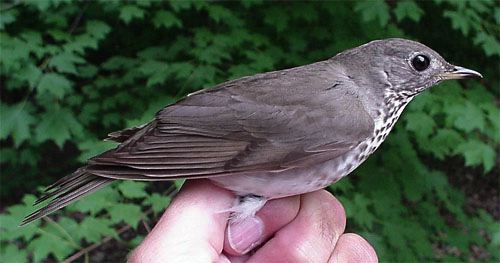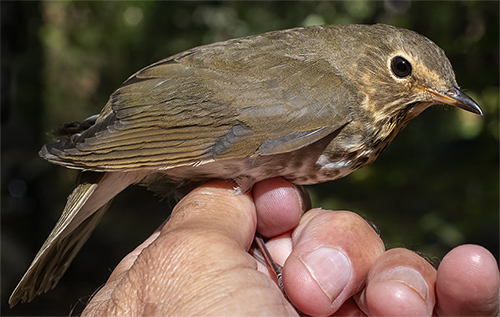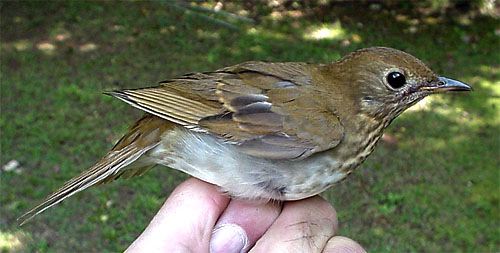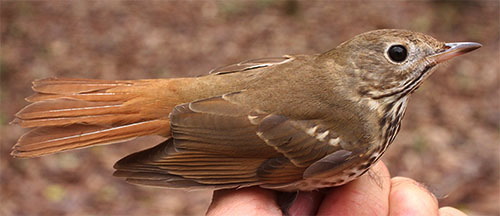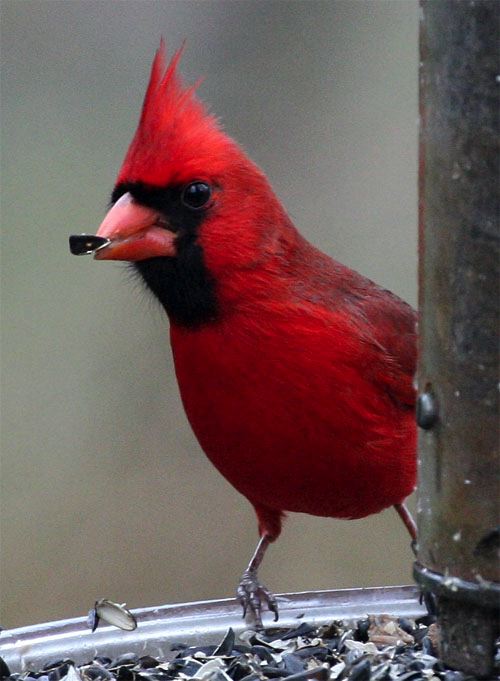- Established 1982 -HOME: www.hiltonpond.org
THIS WEEK at HILTON POND Subscribe for free to our award-winning nature newsletter (Back to Preceding Week; on to Next Week) |
All text, maps, charts & photos © Hilton Pond Center FALL MIGRANT WARBLERS, We banded 27 bird species at Hilton Pond Center during the whole month of September, but the first half of October was nearly as productive with 21 species captured. We would have caught more except several days workers were installing roof shingles (above), gutters (below), and a new deck topping for the old farmhouse.
All text, maps, charts & photos © Hilton Pond Center These noisy alterations helped us humans prepare for winter--just as many birds we banded were dealing with seasonal change by fattening up and flying off to warmer climes in the Neotropics. Some were species that breed much further north and that we see only as migration pass-throughs, while others were locally produced birds destined to become year-round residents on or near the property. We've chosen a few early October bandings to highlight in our 702nd installment of "This Week at Hilton Pond," if only because we see some of them seldom and band them even less.
All text, maps, charts & photos © Hilton Pond Center The "Bird of the Day" (with the longest name) on 8 October was a Black-throated Green Warbler (BTNW)--just the 21st we've banded locally since 1982. This is a bird we spy fairly often during spring and fall migration but seldom catch because it forages mainly in the treetops--rather interesting because its nest usually is not more than about ten feet above the ground. BTNW are usually thought of as northern breeders--they do nest in New England, the Great Lakes states, and most of southern Canada--but also down the Appalachians and Blue Ridge as far as northern Georgia and Alabama. Surprisingly, there is a disjunct breeding population in the Lowcountry cypress swamps of the Carolinas and Virginia.
All text, maps, charts & photos © Hilton Pond Center Adult male BTNW are a bit more colorful than adult females and have a more extensive black throat. The one in our October photo was an immature we identified as male because of a darker line through the eye and black spots very high on the throat (see above)--something less likely to occur in hatch-year females. Most Black-throated Green Warblers have moved through the Carolina Piedmont by the end of September, so we were pleased to catch two "stragglers" in October. [Post & Gauthreaux (1989) list 18 October as the species' late South Carolina record, although we banded one at the Center two days later than that in 1991.]
All text, maps, charts & photos © Hilton Pond Center Tennessee Warbler (TEWA; see photo above) is a migrant parulid whose I.D. seems to give a lot of folks trouble, especially in fall. If the bird lacks wings bars and tail spots, is overall olive green, has an indistinct dark line through the eye--and most diagnostic, we think--has a small, finely pointed bill, it's a TEWA. Breeding TEWA, especially males, have a gray cap. We only get this species in migration and not that frequently; ALL have been caught in autumn. TEWA breed across Canada and barely into the northern tier of the eastern U.S. They are a poorly studied species, perhaps because they hang out in the boreal forest where nests are hard to find.
All text, maps, charts & photos © Hilton Pond Center A Tennessee Warbler banded on 8 October was just our 83rd at Hilton Pond Center in 38 years, so our real familiarity with the species comes mainly from our Neotropical research sites. In Costa Rica, thin-billed and nectar-loving TEWA are by far the most common birds we capture in the flower-rich Chayote fields at Ujarrás, exceeding even our target species--Ruby-throated Hummingbirds. Some days TEWA hit our Chayote-shaded mist nets so frequently we just let them go unbanded because we can't keep up with the never-ending flow! (Our citizen science teams more than once suggested we change the project name from Operation RubyThroat to Operation TEWA!) One TEWA we banded at Ujarrás was recaptured much later in the very same field by our friends and guides Ernesto M. Carman and Paz A. Irola. By then the bird was in its seventh year and established a new longevity record for Tennessee Warblers!
All text, maps, charts & photos © Hilton Pond Center The bird in the photo above might be confusing at first, but a close look at white tail spots, no wing bars, yellow face and breast—plus a pale greenish-yellow back and HOOD tells you this is an immature Hooded Warbler (HOWO) we encountered in early October at Hilton Pond Center. Adult males have a black hood and bib, while young males and females look pretty much alike. Thus, we checked carefully for any black feathers in he crown—there were none—but a wing chord measurement that was relatively short told us for sure this was an immature female. (Older females usually develop a darker hood, and some researchers report an occasional adult female looking just like her mate.)
All text, maps, charts & photos © Hilton Pond Center HOWA (immature female, above) is one of the few Wood Warblers that actually breeds locally. Of an impressive 35 parulids observed since 1982 at the Center, perhaps nine are likely to nest in this part of the Carolina Piedmont; we have captured females with active brood patches for seven of those--including Hooded Warbler. (NOTE: The only "eastern" parulids that might occur around Hilton Pond but haven't been observed locally are Mourning Warbler, Kirtland's Warbler, and Cerulean Warbler--all migrants.)
All text, maps, charts & photos © Hilton Pond Center All told, 55 Hooded Warblers have crossed the Center's banding table since our first one in Autumn 1985. We haven't banded a male HOWA this fall but include a photo of a mature one in breeding plumage (above) for comparison with the female.
All text, maps, charts & photos © Hilton Pond Center Various North American members of the Thrush Family (Turdidae) are very different in appearance, from three kinds of bluebirds to the orange-breasted American Robin to the brown "spot-breasted" thrushes. Actually, one characteristic all thrushes have in common is spotted or streaks at some stage in their life cycle--particular as immatures--remember baby robins?--but the five brown, spot-breasted species retain that field mark into adulthood. Folks sometimes confuse those five, which usually are not that hard to differentiate. (See the field guide page, above)
All text, maps, charts & photos © Hilton Pond Center Perhaps easiest to identify is the Wood Thrush (WOTH), largest of the group, whose breast markings are rounded spots of deep black. Its crown and back are bright chestnut in color. In silhouette the WOTH looks very much like a robin. We caught one this week (and just one all year) at the Center, and 196 since 1982--even though it's has been a local breeder. This is one thrush whose numbers have declined precipitously, likely due to habitat loss on both ends of its Neotropical migratory route.
All text, maps, charts & photos © Hilton Pond Center Our second turdid species banded this week was Gray-cheeked Thrush (GCTH), probably the spot-breasted thrush that is most often misidentified. (We caught three this week and have banded 130 individuals at Hilton Pond Center in 38 years; of these, 92% have been autumn captures.) GCTH lacks a prominent eye ring and has dorsal plumage--head, back, and tail--olive-brown in color. The breast markings are more or less distinct dark streaks, often with a buffy background. A gray cheek is the clincher characteristic.
All text, maps, charts & photos © Hilton Pond Center In September--but not this week--we caught two other spot-breasted thrush species: Swainson's Thrush (SWTH) and Veery (VEER). The SWTH has distinct buffy eye ring and buffy face, brownish to olive dorsum, and fairly distinct breast streaks. Swainson's is by far our most commonly captured spot-breasted thrush, with 546 banded since 1982; 90% of those have been netted during fall migration.
All text, maps, charts & photos © Hilton Pond Center Veeries (above) are rust-colored from head to tail and have breast spots that are less distinct and almost always against a degree of buffiness. The buffy eye ring is noticeable but not prominent. We've banded 101 VEER, once again the majority (72%) during autumn.
All text, maps, charts & photos © Hilton Pond Center The fifth spot-breasted turdid--Hermit Thrush (HETH)--has yet to arrive this fall at Hilton Pond. In fact, this species is always a late fall arrival and is unusual among its relatives in that it spends the winter months at the Center, searching on the ground for insects or their larvae and gleaning what berries it can find. (Most winters we see one or two HETH frequenting our suet feeders.) The species' eye ring and breast streaking are noticeable, but its most important characteristic is its bright rusty tail that it bobs frequently while foraging; rust does NOT extend to the back or hcrown. Our Hermit Thrush banding tally for 38 years is 198 (81% in late fall or early winter). Two HETH we've recaptured several times through the years at Hilton Pond Center demonstrated strong long-term site fidelity; both were caught most recently in early Spring 2019. One had been banded in 2013 (now a 7th-year bird) and the other in 2015 (now 5th-year). The federal Bird Banding Laboratory's record for this species is 10 years 10 months.
All text, maps, charts & photos © Hilton Pond Center (NOTE: Across the eastern U.S., if you see a spot-breasted thrush in winter it is almost certainly a Hermit Thrush. Even then, a brown-backed bird with noticeable breast spots is more likely a Brown Thrasher (above), whose long tail and long, slightly decurved bill are diagnostic. Folks who report a migratory Wood Thrush during a Christmas Bird Count in December or the Great Backyard Bird Count in February are likely misidentifying a resident Brown Thrasher or Hermit Thrush.)
All text, maps, charts & photos © Hilton Pond Center We band lots of non-migratory Northern Cardinals at Hilton Pond Center, but an immature female captured on 9 October was of particular interest. As shown in the photo above, she still had a bill that was dark brown-black rather than the bright orange typically found in adults and in most young NOCA by late fall. In fact, all the other hatch-year cardinals we've caught in recent weeks had bills that were at least two-thirds orange. We suspect this particular female was the result of a very late breeding effort--perhaps even a third brood for her parents--and thus was good news for Hilton Pond cardinals. As this young bird matures and consumes more carotene and xanthophyll pigments in seeds and plant-eating insects she, too, will develop an orange bill. Likewise, much of her somewhat brownish natal plumage will be replaced by new feathers with at least a hint of orange or red. (Notice the tiny new feathers coming in above her eye!)
All text, maps, charts & photos © Hilton Pond Center Northern Cardinals (male, above, likely an immature) are doing very well this year at the Center after a huge drop in their population we believe caused (at least in part) by a mosquito-borne West Nile Virus epidemic starting in the mid-1990s. Through 15 October this year we've banded 91 NOCA in 2019, well ahead of our 38-year average of 76. (Our record high was 157 in 1993; 91 is already the second-best total in the past 12 years, and the tenth-best overall.) With October 2019 already halfway gone, many fall migrant species--especially warblers and thrushes--have already high-tailed it for the Neotropics. It will be interesting to see if any late ones remain at Hilton Pond Center from now until Halloween as our expected winter assemblage of winter-hardy sparrows and finches begins to arrive. All text, maps, charts & photos © Hilton Pond Center
Checks also can be sent to Hilton Pond Center at: All contributions are tax-deductible on your Don't forget to scroll down for Nature Notes & Photos, |
|---|
|
"This Week at Hilton Pond" is written and photographed by Bill Hilton Jr., executive director of Hilton Pond Center for Piedmont Natural History
|
|
|
Please refer "This Week at Hilton Pond" to others by clicking on this button: |
|


